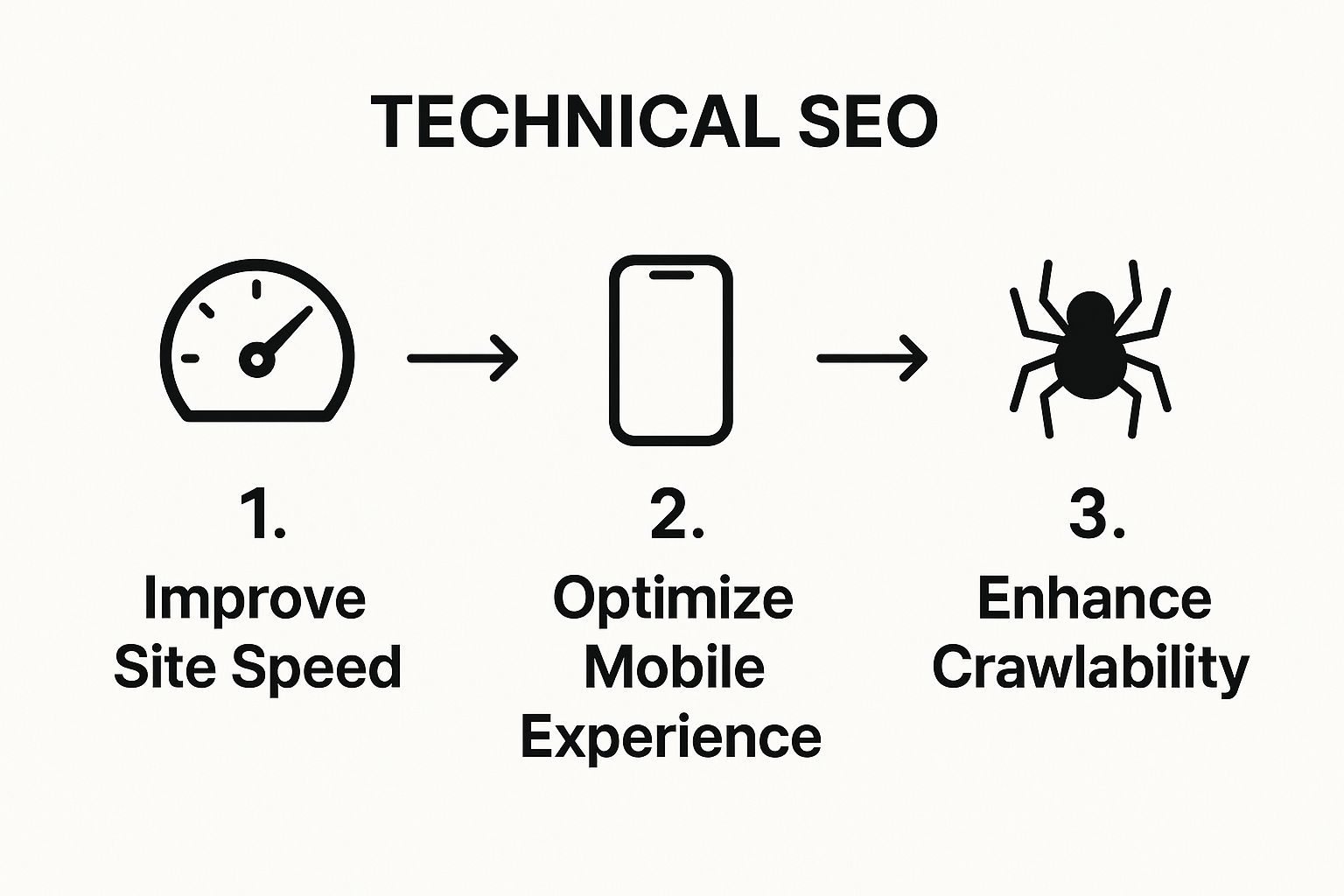If you really want to improve your search engine rankings, you need to think less about gaming the system and more about creating a great, trustworthy experience for people. It all boils down to a balanced strategy that hits four key areas: technical health, on-page optimization, authoritative content, and off-page trust signals. Get these right, and you're not just chasing rankings—you're building a system for long-term, sustainable growth.

The Modern Blueprint for Higher Search Rankings
Trying to keep up with every single algorithm update is a recipe for disaster. A much smarter play is to build a rock-solid, holistic SEO foundation that can weather any changes Google throws your way. This guide gives you that blueprint, moving beyond random tips to a unified strategy that actually works.
Think of your website like a house. Before you can worry about decorating or inviting people over, you have to make sure the foundation is solid and the framing is right. That's exactly what these four pillars of modern SEO do for your site.
The Four Pillars of SEO Success
A winning SEO strategy is a bit like a four-legged stool—if one leg is weak, the whole thing becomes unstable. Neglecting one area can completely tank all the hard work you've put into the others. Here’s a look at how they all fit together.
- A Flawless Technical Foundation: This is non-negotiable. If search engine crawlers can't properly find, access, and understand your site, even the most amazing content in the world will be invisible. We're talking about things like site speed, mobile-friendliness, and a clean, logical site structure.
- Precise On-Page Optimization: This is where you send direct signals to search engines about what your pages are about. It’s way more than just stuffing keywords in. It’s about writing compelling titles, using headings to structure your content, and creating a smart internal linking web to guide both users and crawlers.
- Authoritative Content: Your content has to be the best answer out there for what a user is searching for. That means creating genuinely helpful, in-depth articles that show you know your stuff. You need to demonstrate real experience and build trust by satisfying what the user came for.
- Strong Off-Page Signals: Think of these as votes of confidence from around the web. When reputable sites link to you, you get mentioned in industry articles, or you build a strong local presence, it tells search engines that you're a legitimate authority worth paying attention to.
The big idea here is simple: a technically sound website that features expert content and is trusted by others will naturally climb the rankings. This blueprint helps you systematically build value in the eyes of both your users and the search algorithms.
How to Prioritize Your Efforts
If you're just getting started, the order you do things in really matters. I always recommend kicking things off with a technical audit to patch up any cracks in your foundation. Once that's sorted, turn your attention to optimizing your most important pages—your homepage, key service pages, and any blog posts that are already getting some traction.
At the same time, start mapping out a content plan that directly addresses your audience's biggest questions and problems. As you publish this kind of valuable content, it becomes an asset that naturally attracts backlinks and helps you build that crucial off-page authority.
For anyone running a smaller operation, this ultimate small business SEO guide is a fantastic resource that dives deeper into these concepts. It's all about creating an interconnected process—a cycle of continuous improvement that drives real growth and makes improving your search rankings an achievable goal.
Getting Quick Wins with On-Page SEO

While technical SEO and link building are long-term games, on-page SEO is where you can see results today. This is your direct line of communication with search engines, and it’s your best shot at convincing real people to click on your link instead of a competitor's.
Good on-page optimization is more than just stuffing keywords into your text. It's about intelligently structuring your content, writing search snippets that grab attention, and creating logical pathways through your site. When you nail these things, you create a fantastic user experience, and Google will reward you for it.
Crafting Title Tags That Drive Clicks
Your title tag is the single most important piece of on-page SEO real estate you have. It's the headline of your search result and a major clue to Google about what your page is about. A great title has to be both relevant to the keyword and compelling enough to earn the click.
Think of it like this: "Gardening Tips" is fine, but it’s boring. "15 Gardening Tips for a Thriving Vegetable Patch" is specific, intriguing, and much more likely to get clicked.
Here's a quick rundown for better title tags:
- Keyword first: Put your main keyword phrase as close to the beginning as you can.
- Stay under 60 characters: This is the sweet spot to avoid getting your title cut off in the search results.
- Be unique: Every single page needs its own distinct title tag. No duplicates!
- Add a hook: Use numbers, ask a question, or highlight a clear benefit to stand out.
Structuring Content with Clear Headings
Headings (like H1, H2, and H3 tags) aren't just for making your text look pretty. They build a logical outline that helps people and search engines understand your content's hierarchy. Your H1 tag is the book title—one per page, and it should nail the page's main topic.
The H2s and H3s that follow are like your chapter and section titles. They break your content into bite-sized, scannable pieces, making it way easier to read. For search engines, this structure helps them understand all the subtopics you cover, which can help you rank for a wider range of related searches.
A well-structured page is a user-friendly page. When people can easily scan your content to find what they need, they are more likely to stay on your site longer, sending positive engagement signals back to Google.
The Power of Strategic Internal Linking
Internal links are simply links from one page on your site to another. But they do some heavy lifting! They help users find related content, they pass authority (or "link equity") around your site, and they show search engines how your content is all connected.
When you link from a strong, high-traffic page to a newer page, you're essentially giving that new page a vote of confidence and a little SEO boost.
For example, linking from a popular blog post like "Beginner Photography Tips" to a specific product page for an entry-level camera is a perfect move. It creates a helpful journey for the reader and clearly signals the relationship between those two pages to Google. For more ideas, you can check out our guide on little changes that make a big impact on your content.
Optimizing Your Images and URLs
Don't forget the smaller details! Every single element on your page, right down to the images and URLs, can be fine-tuned for better performance.
Image Alt Text: Alt text is the description that shows up if an image doesn't load. More importantly, it's what screen readers use to describe images to visually impaired users, and it gives search engines crucial context. Instead of a useless filename like "image123.jpg," your alt text should be descriptive, like "gardener planting tomato seedlings in a raised garden bed."
Clean and Descriptive URLs: A good URL is short, easy to read, and contains your main keyword. Which of these makes more sense?
yourdomain.com/p?id=87542yourdomain.com/blog/improving-search-engine-rankings
The second one instantly tells everyone—users and search engines—exactly what the page is about. It's a clear signal of relevance.
This focus on user experience is becoming even more important. The search world is shifting, with 63% of web traffic now coming from mobile and 20.5% of people globally using voice search. Building a strong brand through genuinely helpful content is your best defense, especially as some experts predict a major drop in traditional organic traffic by 2028 because of AI-driven answers.
Building a Flawless Technical SEO Foundation
Let's get one thing straight: your content can be the best in the world, but if search engines can't find, crawl, and understand it efficiently, it's dead in the water. This is the whole point of technical SEO—it's the bedrock for everything else you do.
Ignoring the technical side is like building a gorgeous house on a shaky foundation. Sooner or later, things start to crumble. But don't worry, technical SEO isn't about some secret developer handshake. It's really about making your website fast, secure, and a breeze for search engine bots to navigate. A technically sound website is a user-friendly website, and that's something Google rewards directly.
This visual flow breaks down the core sequence for a technical SEO health checkup.

As the graphic shows, a solid technical strategy kicks off with speed, ensures mobile-friendliness, and is kept in check with easy crawlability.
Master Your Site Speed with Core Web Vitals
Site speed is not just a "nice-to-have" anymore; it's a confirmed ranking factor. Google uses a specific set of metrics called Core Web Vitals to measure the real-world user experience of a page, zeroing in on loading performance, interactivity, and visual stability.
Think about it from a user's perspective. When they click your link, how fast does the main content load? Can they click on a button right away, or does the page just hang there? Does the whole layout shift around as images and ads pop in? These are precisely the questions Core Web Vitals answer.
A slow site is a frustrating site. Studies have shown that even a one-second delay in page load time can cause a significant drop in conversions. Nailing your site speed is one of the most direct ways to improve search engine rankings because it’s a win for both your users and Google's bots.
Your main objective is to get all three Core Web Vitals metrics into the "Good" category. You can use tools like Google's PageSpeed Insights to analyze your pages and get a straightforward report card on how you're doing.
To give you a clearer picture, here are the targets you should be aiming for with Core Web Vitals.
Core Web Vitals Performance Targets
| Metric | What It Measures | Good Score | Needs Improvement | Poor Score |
|---|---|---|---|---|
| LCP (Largest Contentful Paint) | The time it takes for the largest content element (e.g., image, text block) on the page to become visible. | Under 2.5 seconds | 2.5s to 4.0s | Over 4.0 seconds |
| FID (First Input Delay) | The time from when a user first interacts with a page (e.g., clicks a link) to the time when the browser is actually able to respond. | Under 100 ms | 100 ms to 300 ms | Over 300 ms |
| CLS (Cumulative Layout Shift) | The measurement of unexpected layout shifts that occur during the lifespan of the page. | Under 0.1 | 0.1 to 0.25 | Over 0.25 |
Getting a handle on these metrics and working to improve them is a huge step toward building a better user experience that search engines will favor.
Conduct a Basic Technical Health Audit
You don't need to be a coding wizard to spot major technical problems. Your best friend here is Google Search Console, a completely free tool that acts as a direct line of communication between you and Google. It's the first place you should look for trouble.
Once you're inside Search Console, head over to the "Coverage" report. This is your command center. It shows you which pages have been indexed and—more importantly—which ones have errors preventing them from showing up in search.
You'll often run into issues like:
- 404 errors (Not Found): These are broken links that point to pages that no longer exist.
- Server errors (5xx): This means something is wrong with your website's server.
- Redirect errors: Problems with how one URL is supposed to point to another.
Fixing these crawl errors is crucial. It ensures search engines can access all your valuable content without hitting dead ends. Making a habit of checking this report once a month is a fantastic way to stay on top of things.
Guide Crawlers with Sitemaps and Robots.txt
To help search engines discover and understand your site's structure, you need two key files: an XML sitemap and a robots.txt file.
Think of an XML sitemap as a map of your website. It lists all of your important pages, essentially telling search engines, "Hey, this is all the content I want you to look at and index." Most modern website platforms like WordPress can generate this for you automatically. Once it's ready, you just submit it through Google Search Console.
The robots.txt file, on the other hand, does the opposite. It gives crawlers instructions on which parts of your site they shouldn't access. This is super useful for blocking things like admin login pages, internal search results, or duplicate content from being indexed. When used correctly, it helps focus the crawler's time and energy on your most important pages.
Implement Security and Structured Data
Two final technical touches can give you a pretty significant edge: site security and structured data.
First up, HTTPS Security. Having a secure website (you'll see "HTTPS" in your URL) is non-negotiable these days. Google confirmed it as a lightweight ranking signal years ago, but its real value is in building user trust. Modern browsers actively warn users when a site isn't secure, which is a surefire way to increase your bounce rate.
Next is Structured Data (Schema Markup). This is a special type of code you add to your pages to give search engines more detailed info about your content. For instance, you can use it to tell Google that a piece of content is a recipe, a review, a product, or an upcoming event.
Why bother? Because providing this extra context can help you earn rich snippets in the search results. You've seen these—they're the enhanced listings with star ratings, review counts, or cooking times. They make your listing pop off the page, which can seriously boost your click-through rate, even if your actual ranking position doesn't change.
Creating Content That Actually Ranks

Technical fixes and all the on-page stuff are important, don't get me wrong. But at the end of the day, the real engine behind any successful SEO strategy is exceptional content. If your articles and guides don't genuinely help people solve a problem, you’re just spinning your wheels.
Creating content that actually climbs the rankings means you have to stop chasing keywords and start answering the real questions your audience is asking. It’s about becoming the go-to, most comprehensive resource in your space. When you deliver that kind of value consistently, you earn trust from both your audience and Google, which is the secret sauce to improving search engine rankings for good.
Modern Keyword Research Focusing on Intent
The old days of finding a high-volume keyword and cramming it into a page are long gone. Thank goodness. Today, it’s all about understanding user intent—the “why” behind every single search.
Think about it: when someone types into that Google search bar, they have a mission. Are they trying to learn something? Buy something? Find a specific website? Your job is to play detective and create content that perfectly matches that mission.
For instance, someone searching for "best running shoes for beginners" isn't just looking for a product page. Their intent is informational, with a bit of commercial interest mixed in. They want comparisons, solid advice, and trustworthy recommendations. The content that wins here will always be a detailed guide that helps them make a smart choice.
Building Topical Authority with Content Clusters
Instead of pumping out random one-off articles, the game-changing strategy is to build topical authority. This is how you prove to search engines that you're a legitimate expert on a particular subject. The best way I’ve found to do this is by using the pillar page and topic cluster model.
Here’s the breakdown:
- Pillar Page: This is your magnum opus on a broad topic, like "A Complete Guide to Content Marketing." It’s the central hub.
- Topic Clusters: Think of these as supporting articles that dive deep into specific subtopics, like "How to Create a Content Calendar" or "Measuring Content Marketing ROI."
- Internal Linking: Here's the magic. Every cluster article links back up to the main pillar page. In turn, the pillar page links out to all its cluster articles.
This structure creates a powerful, interconnected web of content. It sends a massive signal to Google that you haven't just skimmed the surface—you've covered a topic from every possible angle. It's an incredible way to improve rankings for a whole bunch of related keywords. For small businesses getting their feet wet, our guide to content marketing for small businesses is a fantastic primer on this model.
Creating the Best Answer on the SERP
Before you type a single word, you need to do your homework. That means analyzing the current search engine results page (SERP) for your target keyword. This isn't about copying what your competitors are doing. It's about understanding what Google already thinks is a great answer and then figuring out how you can blow it out of the water.
Take a look at the top 5-10 results and ask yourself:
- What formats are winning? Are they blog posts, videos, or product pages?
- What specific subtopics are covered?
- What's showing up in the "People Also Ask" box? Those are goldmines.
- How long and in-depth is the top-ranking content?
- Is there an obvious gap? A question they all missed or answered poorly?
Your goal is simple: create something that is 10x better than anything else on that page. Maybe that means you provide more detail, add original research, create sharper visuals, or just explain something complicated in a way that’s way easier to understand.
By studying the SERP first, you stop guessing what might work. You’re using Google's own data to reverse-engineer a winning content strategy and create something that truly deserves that #1 spot.
Demonstrating E-E-A-T and Refreshing Key Content
Google is getting smarter about quality, and a big part of that is E-E-A-T: Experience, Expertise, Authoritativeness, and Trustworthiness. This means your content needs to be accurate, well-researched, and ideally, written by someone who actually knows their stuff.
You can signal E-E-A-T in a few ways. Add author bios that list credentials, cite your sources (especially reputable ones), and share real-world case studies or personal stories. It’s all about proving you’re not just making things up.
Finally, remember that your job isn't over when you hit "publish." SEO is a long game, and that includes keeping your content fresh. Make it a habit to go back and review your most important articles. Update old stats, add new insights, and fix any broken links. A simple content refresh can give you a serious ranking boost because it tells Google your information is still relevant and valuable.
Earning Authority with Off-Page and Local SEO
What happens away from your website can have a massive impact on your ability to rank. It's a hard truth, but even the best on-page SEO can fall flat without a solid off-page strategy. Search engines need to see that other reputable sources trust your content, and these external "votes of confidence" are what off-page SEO is all about.
At its core, off-page SEO is all about building authority. And while there are many ways to do this, the most powerful signal is still a high-quality backlink—a link from another website pointing to yours.
Think of it like a personal recommendation. If a major industry publication links to your guide, it's like a respected expert vouching for your work. On the flip side, a link from a spammy, low-quality site can do more harm than good. The goal isn't just to get links; it's to earn them from the right places.
Strategies for Earning Quality Backlinks
Let's get one thing straight: old-school, spammy tactics like buying links are a surefire way to get penalized by Google. The modern approach is all about creating assets so genuinely valuable that people want to link to them.
Here are a few effective ways to do that:
- Create linkable assets: This means publishing original research, building a free tool, or writing the most comprehensive guide on a topic in your industry. Make it the go-to resource people can't help but reference.
- Digital PR and outreach: This is just a fancy way of saying you need to build relationships with journalists, bloggers, and influencers in your space. When you publish something newsworthy, you'll have a network ready to listen and share.
- Guest blogging: Writing an article for another reputable website in your niche is a classic for a reason. It gets your name out there and earns you a relevant, high-authority backlink.
If you want to go deeper on this, check out our guide on different ways to boost inbound traffic to your website, which covers even more off-page strategies.
Winning Locally with Google Business Profile
For any business with a physical location or a defined service area, local SEO isn't just important—it's everything. Your most powerful tool here is your Google Business Profile (GBP). It's that info box that pops up in Google Maps and local search results, and keeping it optimized is your top priority.
A fully fleshed-out GBP profile is your virtual storefront. It tells potential customers your hours, address, services, and shows them photos of your work. Neglecting it is like leaving your front door locked during business hours.
Recent data shows just how much a well-managed profile matters. A 2025 study from Search Atlas revealed that your chosen business category contributes about 21% to your local ranking power. Reviews are also huge, with keyword relevance inside a review accounting for 11% of your ranking ability—that's more than the sheer volume of reviews, which sits at 8%. Even having a target keyword in your business name can give you a 7% bump.
The takeaway is clear: a complete and active Google Business Profile is the cornerstone of any local SEO effort. It builds trust, provides crucial information, and directly influences your visibility in local searches.
The Importance of Local Citations and NAP Consistency
Beyond your GBP, you need to make sure your business information is consistent everywhere it shows up online. This is where local citations come into play. A citation is any online mention of your business's Name, Address, and Phone number—often called NAP.
These citations pop up in online directories like Yelp, on industry-specific websites, or on local chamber of commerce pages. The absolute key here is NAP consistency.
When search engines see the exact same NAP information across dozens of trusted sites, it solidifies their confidence that your business is legitimate and located where you claim. Any inconsistencies, like an old address or a wrong phone number, create confusion and can seriously damage your local rankings. Regularly auditing your citations to ensure they are accurate is a simple but incredibly powerful maintenance task.
Common Questions About Improving Rankings
Even with a solid plan, a few questions always pop up when you start digging into SEO. Getting clear, no-nonsense answers is key to making sure you're putting your effort where it counts. Let's tackle some of the ones I hear most often.
How Long Does It Realistically Take to See Results?
This is the big one, and the honest-to-goodness answer is… it depends. SEO is a long game, not an overnight fix.
For a completely new website in a tough industry, you're probably looking at 6 to 12 months before you see real movement for the keywords that matter. Think of it like planting a tree; consistent effort is what helps it grow strong over time.
But if your site already has some history and authority, you might spot some progress for less competitive keywords within 3 to 6 months. You can often get quick wins by cleaning up technical problems or tweaking existing content, but long-term success comes from consistently creating great stuff and building your reputation.
Which Is More Important: On-Page or Off-Page SEO?
This is like asking if you need an engine or wheels on a car. You absolutely need both. They're two sides of the same coin, and one is pretty useless without the other.
Here’s how I think about it:
- On-page SEO is your foundation. It's about making your site easy for search engines to crawl and for people to use. If you skip this, everything else you do is built on unstable ground.
- Off-page SEO, especially link building, is your site's reputation. It’s the proof from other places online that you're a trustworthy, authoritative voice on your topic.
A perfectly optimized site with zero authority will have a hard time ranking for competitive terms. On the flip side, a site with amazing backlinks pointing to a slow, confusing page is going to fall flat. You have to balance both.
A winning SEO strategy blends on-page relevance with off-page authority. One tells Google what you’re about; the other proves you’re credible enough to rank. Don't sacrifice one for the other.
Can I Do SEO Myself, or Should I Hire an Expert?
You can definitely get started on your own, particularly if you're running a small business or a personal site. The basics of on-page SEO and content creation we’ve covered in this guide are totally doable if you're willing to put in the time to learn.
The choice usually boils down to two things: time and competition. If you have the hours to dedicate to learning and doing the work consistently, DIY SEO can be incredibly rewarding.
But if you’re in a crowded market or just don't have the time to do it right, bringing in a good SEO professional can speed up your results significantly. They bring an expert eye and experience that's hard to gain on your own.
Ready to turn your content into a traffic-driving machine? Copy Masters creates search-optimized articles that help you climb the rankings and attract a steady stream of customers. Learn more about our risk-free SEO content writing service.
- A Guide to B2B SaaS Marketing - August 16, 2025
- Improving Search Engine Rankings: Your Practical Masterclass - August 15, 2025
- Copywriting vs. Content Writing: Which is Better for Your Marketing? - August 13, 2025
